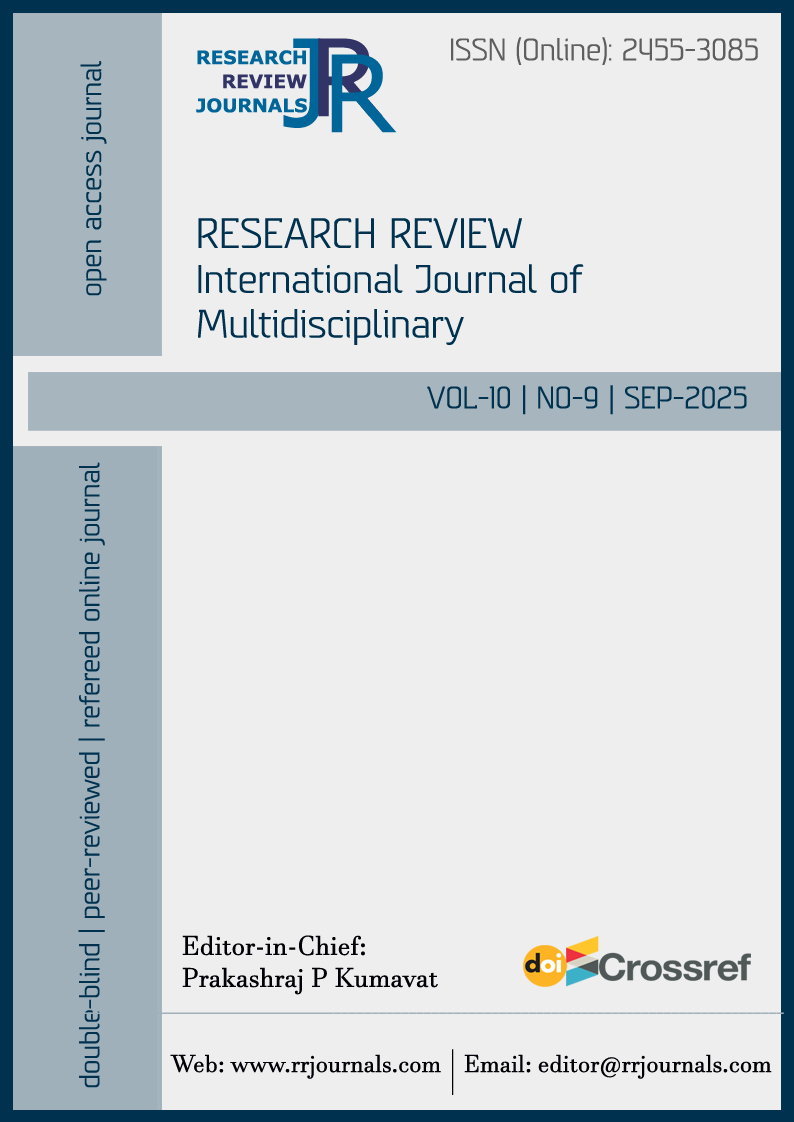Cultural beliefs, taboos and their influence on menstrual health among ST Women in South 24 Parganas District, West Bengal
DOI:
https://doi.org/10.31305/rrijm.2025.v10.n9.005Keywords:
Menstrual Health and Hygiene (MHH), Cultural Beliefs, Taboos, Women’s HealthAbstract
Menstrual health and hygiene (MHH) is not just a medical problem but also a deeply embedded societal phenomena, especially for Scheduled Tribe (ST) inhabitants living in impoverished locations. The cultural taboos, constraints, and beliefs around menstruation are examined in this study, along with how they affect the menstrual health practices of ST women in West Bengal's South 24 Parganas district. Data were gathered using a mixed-method approach that included focus groups, household surveys, and in-depth interviews with older members, married women, and teenage girls in a few chosen tribal communities. The results show that eating, moving around, practicing religion, and interacting with others in the home are all restricted since menstruation is frequently seen as immoral. These ideas have a big impact on people's adoption of sanitary menstruation behaviours, which keeps them using risky disposal techniques and conventional absorbents. Intergenerational narratives, inadequate water and sanitation infrastructure, limited understanding, and low access to hygienic products all contribute to the perpetuation of these behaviours. The study emphasizes how cultural beliefs influence menstrual health outcomes by interacting with poverty, education, and health infrastructure. From the study ,91% of respondents were accustomed to wearing unclean reusable clothing, and 68% believed that reusable clothing could not pose any health risks. Nearly 52% of women did not obtain any medical assistance for managing problems related to their periods. It ends with suggestions for integrating policies, raising community knowledge, and implementing culturally responsive interventions to help tribal women in the area manage their menstrual health.
References
Behera, S., Sahoo, H., & Nayak, S. (2023). Menstrual hygiene practices among Juang women in Odisha: Perceptions, restrictions, and health implications. Journal of Family Medicine and Primary Care, 12(3), 512–520. https://doi.org/10.4103/jfmpc.jfmpc_36_23
Chakraborty, T., Roy, A., & Mondal, S. (2024). Menstrual hygiene practices among tribal women of West Bengal: A study from Paschim Bardhaman district. Indian Journal of Public Health, 68(2), 134–140. https://doi.org/10.4103/ijph.ijph_134_24
Das, A., Sharma, R., & Singh, P. (2023). Menstrual hygiene management among tribal women in India: A systematic review. BMC Public Health, 23(1875). https://doi.org/10.1186/s12889-023-1875-0
Dasgupta, A., & Sarkar, M. (2021). Knowledge and practices related to menstruation among Munda adolescent girls: A cross-sectional study. Indian Nursing Journal, 30(1), 45–52.
Garg, S., & Anand, T. (2015). Menstruation related myths in India: Strategies for combating it. Journal of Family Medicine and Primary Care, 4(2), 184–186. https://doi.org/10.4103/2249-4863.154627
Kaur, P., & Kaur, R. (2024). Menstrual hygiene behaviour among the tribal adolescent girls: A cross-sectional study. Journal of Family Medicine and Primary Care, 13(5), 752–760. https://doi.org/10.4103/jfmpc.jfmpc_752_24
Kumar, R. (2020). Breaking the silence: Menstrual taboos and stigma in rural India. Global Public Policy Review, 2(1), 56–62.
McMahon, S. A., Winch, P. J., Caruso, B. A., Obure, A. F., Ogutu, E. A., Ochari, I. A., & Rheingans, R. D. (2011). The girl with her period is the one to hang her head: Reflections on menstrual management among schoolgirls in rural Kenya. BMC International Health and Human Rights, 11(7), 1–10. https://doi.org/10.1186/1472-698X-11-7
Mukherjee, A. G., Roy, S., Das, D. K., & Banerjee, N. (2024). Menstrual hygiene behaviour among the tribal married women aged 15 to 49 years: A cross-sectional study in a community development block of Paschim Bardhaman District, West Bengal. Journal of Family Medicine and Primary Care, 13(5), 1843-1849.
Nair, S., Ghosh, R., & Choudhury, P. (2024). Reproductive health awareness and menstrual taboos among tribal adolescent girls in India. BMC Public Health, 24(18296). https://doi.org/10.1186/s12889-024-18296-1
Ranade, K. (2019). Menstruation huts and the politics of purity: Tribal women’s lived experiences in India. Gender & Society, 33(4), 569–591. https://doi.org/10.1177/0891243219834556
SHARE Consortium, London School of Hygiene and Tropical Medicine. (2017). Policy brief: Menstrual hygiene management. Retrieved September 21, 2021, from http://www.menstrualhygieneday.org/wp-content/uploads/2017/01/SHARE_-MHM_policybrief_2017.pdf
Sinha, R., & Paul, A. (2018). Culture and menstruation: Beliefs and practices in Indian society. Sociological Bulletin, 67(3), 345–359. https://doi.org/10.1177/0038022918779248
Tribal Development Department of West Bengal. (n.d.). Tribal Development Department of West Bengal. Retrieved January 2, 2024, from https://adibasikalyan.gov.in/html/st.php
Vikaspedia. (n.d.). Social welfare: Scheduled tribe welfare. Retrieved January 2, 2024, from https://vikaspedia.in/social-welfare/scheduled-tribes-welfare/particularly-vulnerable-tribal-groups
World Health Organization & UNICEF. (2012). Consultation on draft long list of goal, target and indicator options for future global monitoring of water, sanitation and hygiene. Retrieved September 21, 2021, from https://washdata.org/sites/default/files/documents/reports/2017-06/JMP-2012-post2015-consultation.pdf
Downloads
Published
How to Cite
Issue
Section
License

This work is licensed under a Creative Commons Attribution-NonCommercial 4.0 International License.
This is an open access article under the CC BY-NC-ND license Creative Commons Attribution-Noncommercial 4.0 International (CC BY-NC 4.0).



